Classifying Chemicals with Description Graphs and Logic Programming
- 1. C LASSIFYING C HEMICALS U SING D ESCRIPTION G RAPHS AND L OGIC P ROGRAMMING Despoina Magka, Boris Motik and Ian Horrocks Department of Computer Science, University of Oxford May 28, 2012
- 2. O UTLINE 1 M OTIVATION 2 DGLP S , I MPLEMENTATION AND OVERVIEW 1
- 3. M ODELLING C HEMICALS WITH OWL OWL used for the representation of molecular structures 2
- 4. M ODELLING C HEMICALS WITH OWL OWL used for the representation of molecular structures Classification of chemical compounds [Villanueva-Rosales & Dumontier, OWLED 2007] 2
- 5. M ODELLING C HEMICALS WITH OWL OWL used for the representation of molecular structures Classification of chemical compounds [Villanueva-Rosales & Dumontier, OWLED 2007] Chemical information integration [Konyk et al., DILS, 2008 ] 2
- 6. M ODELLING C HEMICALS WITH OWL OWL used for the representation of molecular structures Classification of chemical compounds [Villanueva-Rosales & Dumontier, OWLED 2007] Chemical information integration [Konyk et al., DILS, 2008 ] Subsumptions between molecules and chemical classes [Hastings et al., OWLED, 2010] 2
- 7. T HE C H EBI O NTOLOGY OWL ontology Chemical Entities of Biological Interest 3
- 8. T HE C H EBI O NTOLOGY OWL ontology Chemical Entities of Biological Interest Freely accessible dictionary of ‘small’ molecular entities 3
- 9. T HE C H EBI O NTOLOGY OWL ontology Chemical Entities of Biological Interest Freely accessible dictionary of ‘small’ molecular entities High quality annotation and taxonomy of chemicals 3
- 10. T HE C H EBI O NTOLOGY OWL ontology Chemical Entities of Biological Interest Freely accessible dictionary of ‘small’ molecular entities High quality annotation and taxonomy of chemicals Interoperability between researchers 3
- 11. T HE C H EBI O NTOLOGY OWL ontology Chemical Entities of Biological Interest Freely accessible dictionary of ‘small’ molecular entities High quality annotation and taxonomy of chemicals Interoperability between researchers Drug discovery and elucidation of metabolic pathways 3
- 12. AUTOMATE C HEMICAL C LASSIFICATION ChEBI is manually incremented 4
- 13. AUTOMATE C HEMICAL C LASSIFICATION ChEBI is manually incremented Currently contains approx. 28,000 fully annotated entities 4
- 14. AUTOMATE C HEMICAL C LASSIFICATION ChEBI is manually incremented Currently contains approx. 28,000 fully annotated entities Grows at a rate of ~1,500 entities per curator per year 4
- 15. AUTOMATE C HEMICAL C LASSIFICATION ChEBI is manually incremented Currently contains approx. 28,000 fully annotated entities Grows at a rate of ~1,500 entities per curator per year Biologically interesting entities possibly > 1,000,000 4
- 16. AUTOMATE C HEMICAL C LASSIFICATION ChEBI is manually incremented Currently contains approx. 28,000 fully annotated entities Grows at a rate of ~1,500 entities per curator per year Biologically interesting entities possibly > 1,000,000 Each new molecule is subsumed by several chemical classes 4
- 17. AUTOMATE C HEMICAL C LASSIFICATION ChEBI is manually incremented Currently contains approx. 28,000 fully annotated entities Grows at a rate of ~1,500 entities per curator per year Biologically interesting entities possibly > 1,000,000 Each new molecule is subsumed by several chemical classes Is dinitrogen inorganic? 4
- 18. AUTOMATE C HEMICAL C LASSIFICATION ChEBI is manually incremented Currently contains approx. 28,000 fully annotated entities Grows at a rate of ~1,500 entities per curator per year Biologically interesting entities possibly > 1,000,000 Each new molecule is subsumed by several chemical classes Is dinitrogen inorganic? Does cyclobutane contain a four-membered ring? 4
- 19. AUTOMATE C HEMICAL C LASSIFICATION ChEBI is manually incremented Currently contains approx. 28,000 fully annotated entities Grows at a rate of ~1,500 entities per curator per year Biologically interesting entities possibly > 1,000,000 Each new molecule is subsumed by several chemical classes Is dinitrogen inorganic? Does cyclobutane contain a four-membered ring? Is acetylene a hydrocarbon? 4
- 20. AUTOMATE C HEMICAL C LASSIFICATION ChEBI is manually incremented Currently contains approx. 28,000 fully annotated entities Grows at a rate of ~1,500 entities per curator per year Biologically interesting entities possibly > 1,000,000 Each new molecule is subsumed by several chemical classes Is dinitrogen inorganic? Does cyclobutane contain a four-membered ring? Is acetylene a hydrocarbon? Does benzaldehyde contain a benzene ring? 4
- 21. AUTOMATE C HEMICAL C LASSIFICATION ChEBI is manually incremented Currently contains approx. 28,000 fully annotated entities Grows at a rate of ~1,500 entities per curator per year Biologically interesting entities possibly > 1,000,000 Each new molecule is subsumed by several chemical classes Is dinitrogen inorganic? Does cyclobutane contain a four-membered ring? Is acetylene a hydrocarbon? Does benzaldehyde contain a benzene ring? Speed up curating tasks with automated reasoning tools 4
- 22. AUTOMATE C HEMICAL C LASSIFICATION ChEBI is manually incremented Currently contains approx. 28,000 fully annotated entities Grows at a rate of ~1,500 entities per curator per year Biologically interesting entities possibly > 1,000,000 Each new molecule is subsumed by several chemical classes Is dinitrogen inorganic? Yes Does cyclobutane contain a four-membered ring? Yes Is acetylene a hydrocarbon? Yes Does benzaldehyde contain a benzene ring? Yes Speed up curating tasks with automated reasoning tools 4
- 23. (M IS )R EPRESENTING R INGS WITH OWL Chemical compounds with rings are highly frequent 5
- 24. (M IS )R EPRESENTING R INGS WITH OWL Chemical compounds with rings are highly frequent Fundamental inability of OWL to represent cycles 5
- 25. (M IS )R EPRESENTING R INGS WITH OWL Chemical compounds with rings are highly frequent Fundamental inability of OWL to represent cycles At least one tree-shaped model for each consistent OWL knowledge base 5
- 26. (M IS )R EPRESENTING R INGS WITH OWL Chemical compounds with rings are highly frequent Fundamental inability of OWL to represent cycles At least one tree-shaped model for each consistent OWL knowledge base E XAMPLE Cyclobutane ∃(= 4)hasAtom.(Carbon ∃(= 2)hasBond.Carbon) C C C C 5
- 27. (M IS )R EPRESENTING R INGS WITH OWL Chemical compounds with rings are highly frequent Fundamental inability of OWL to represent cycles At least one tree-shaped model for each consistent OWL knowledge base E XAMPLE Cyclobutane ∃(= 4)hasAtom.(Carbon ∃(= 2)hasBond.Carbon) C C C C 5
- 28. (M IS )R EPRESENTING R INGS WITH OWL Chemical compounds with rings are highly frequent Fundamental inability of OWL to represent cycles At least one tree-shaped model for each consistent OWL knowledge base E XAMPLE Cyclobutane ∃(= 4)hasAtom.(Carbon ∃(= 2)hasBond.Carbon) C C C C 5
- 29. (M IS )R EPRESENTING R INGS WITH OWL Chemical compounds with rings are highly frequent Fundamental inability of OWL to represent cycles At least one tree-shaped model for each consistent OWL knowledge base E XAMPLE Cyclobutane ∃(= 4)hasAtom.(Carbon ∃(= 2)hasBond.Carbon) C C C C OWL-based reasoning support 5
- 30. (M IS )R EPRESENTING R INGS WITH OWL Chemical compounds with rings are highly frequent Fundamental inability of OWL to represent cycles At least one tree-shaped model for each consistent OWL knowledge base E XAMPLE Cyclobutane ∃(= 4)hasAtom.(Carbon ∃(= 2)hasBond.Carbon) C C C C OWL-based reasoning support Does cyclobutane contain a four-membered ring? Does benzaldehyde contain a benzene ring? 5
- 31. OWL E XTENSIONS Limitation of OWL to represent cycles (partially) remedied by extension of OWL with Description Graphs and rules [Motik et al., 2009] 6
- 32. OWL E XTENSIONS Limitation of OWL to represent cycles (partially) remedied by extension of OWL with Description Graphs and rules [Motik et al., 2009] A Description Graph represents structures by means of a directed labeled graph 6
- 33. OWL E XTENSIONS Limitation of OWL to represent cycles (partially) remedied by extension of OWL with Description Graphs and rules [Motik et al., 2009] A Description Graph represents structures by means of a directed labeled graph E XAMPLE Cyclobutadiene 1 C C Carbon 2 3 Carbon C C Carbon 5 4 Carbon 6
- 34. OWL E XTENSIONS Limitation of OWL to represent cycles (partially) remedied by extension of OWL with Description Graphs and rules [Motik et al., 2009] A Description Graph represents structures by means of a directed labeled graph E XAMPLE Cyclobutadiene 1 C C Carbon 2 3 Carbon C C Carbon 5 4 Carbon 6
- 35. OWL E XTENSIONS Limitation of OWL to represent cycles (partially) remedied by extension of OWL with Description Graphs and rules [Motik et al., 2009] A Description Graph represents structures by means of a directed labeled graph E XAMPLE Cyclobutadiene 1 C C Carbon 2 3 Carbon C C Carbon 5 4 Carbon Does cyclobutadiene have a conjugated four-membered ring? 6
- 36. OWL E XTENSIONS Limitation of OWL to represent cycles (partially) remedied by extension of OWL with Description Graphs and rules [Motik et al., 2009] A Description Graph represents structures by means of a directed labeled graph E XAMPLE Cyclobutadiene 1 C C Carbon 2 3 Carbon C C Carbon 5 4 Carbon Does cyclobutadiene have a conjugated four-membered ring? 6
- 37. OWL E XTENSIONS Limitation of OWL to represent cycles (partially) remedied by extension of OWL with Description Graphs and rules [Motik et al., 2009] A Description Graph represents structures by means of a directed labeled graph E XAMPLE Cyclobutadiene 1 Oxygen C C Carbon 2 3 Carbon C C Carbon 5 4 Carbon 6
- 38. OWL E XTENSIONS Limitation of OWL to represent cycles (partially) remedied by extension of OWL with Description Graphs and rules [Motik et al., 2009] A Description Graph represents structures by means of a directed labeled graph E XAMPLE Cyclobutadiene 1 Oxygen C C Carbon 2 3 Carbon C C Carbon 5 4 Carbon ∀hasAtom.(Carbon Hydrogen) Hydrocarbon 6
- 39. OWL E XTENSIONS Limitation of OWL to represent cycles (partially) remedied by extension of OWL with Description Graphs and rules [Motik et al., 2009] A Description Graph represents structures by means of a directed labeled graph E XAMPLE Cyclobutadiene 1 Oxygen C C Carbon 2 3 Carbon C C Carbon 5 4 Carbon ∀hasAtom.(Carbon Hydrogen) Hydrocarbon Is cyclobutadiene a hydrocarbon? 6
- 40. OWL E XTENSIONS Limitation of OWL to represent cycles (partially) remedied by extension of OWL with Description Graphs and rules [Motik et al., 2009] A Description Graph represents structures by means of a directed labeled graph E XAMPLE Cyclobutadiene 1 Oxygen C C Carbon 2 3 Carbon C C Carbon 5 4 Carbon ∀hasAtom.(Carbon Hydrogen) Hydrocarbon Is cyclobutadiene a hydrocarbon? 6
- 41. R ESULTS OVERVIEW Key idea: 7
- 42. R ESULTS OVERVIEW Key idea: Switch from first-order logic to logic programming semantics 7
- 43. R ESULTS OVERVIEW Key idea: Switch from first-order logic to logic programming semantics Replace classical negation with negation-as-failure 7
- 44. R ESULTS OVERVIEW Key idea: Switch from first-order logic to logic programming semantics Replace classical negation with negation-as-failure Double benefit: 7
- 45. R ESULTS OVERVIEW Key idea: Switch from first-order logic to logic programming semantics Replace classical negation with negation-as-failure Double benefit: 1 Encode chemical classes based on the absence of information 7
- 46. R ESULTS OVERVIEW Key idea: Switch from first-order logic to logic programming semantics Replace classical negation with negation-as-failure Double benefit: 1 Encode chemical classes based on the absence of information (e.g. hydrocarbons, inorganic molecules, saturated compounds,. . . ) 7
- 47. R ESULTS OVERVIEW Key idea: Switch from first-order logic to logic programming semantics Replace classical negation with negation-as-failure Double benefit: 1 Encode chemical classes based on the absence of information (e.g. hydrocarbons, inorganic molecules, saturated compounds,. . . ) 2 Represent rings with adequate precision 7
- 48. R ESULTS OVERVIEW Key idea: Switch from first-order logic to logic programming semantics Replace classical negation with negation-as-failure Double benefit: 1 Encode chemical classes based on the absence of information (e.g. hydrocarbons, inorganic molecules, saturated compounds,. . . ) 2 Represent rings with adequate precision (e.g. cycloalkanes, benzene rings,. . . ) 7
- 49. R ESULTS OVERVIEW Key idea: Switch from first-order logic to logic programming semantics Replace classical negation with negation-as-failure Double benefit: 1 Encode chemical classes based on the absence of information (e.g. hydrocarbons, inorganic molecules, saturated compounds,. . . ) 2 Represent rings with adequate precision (e.g. cycloalkanes, benzene rings,. . . ) Expressive decidable logic-based formalism for modelling structured entities: Description Graph Logic Programs (DGLPs) 7
- 50. R ESULTS OVERVIEW Key idea: Switch from first-order logic to logic programming semantics Replace classical negation with negation-as-failure Double benefit: 1 Encode chemical classes based on the absence of information (e.g. hydrocarbons, inorganic molecules, saturated compounds,. . . ) 2 Represent rings with adequate precision (e.g. cycloalkanes, benzene rings,. . . ) Expressive decidable logic-based formalism for modelling structured entities: Description Graph Logic Programs (DGLPs) Prototypical implementation of a logic-based chemical classification software 7
- 51. O UTLINE 1 M OTIVATION 2 DGLP S , I MPLEMENTATION AND OVERVIEW 8
- 52. W HAT IS A DGLP O NTOLOGY ? The syntactic objects of a DGLP ontology: 9
- 53. W HAT IS A DGLP O NTOLOGY ? The syntactic objects of a DGLP ontology: Description graphs 9
- 54. W HAT IS A DGLP O NTOLOGY ? The syntactic objects of a DGLP ontology: Description graphs E XAMPLE Cyclobutane 1 O O Dioxygen 1 C C Carbon 2 3 Carbon C C Carbon 5 4 Carbon Oxygen 2 3 Oxygen 9
- 55. W HAT IS A DGLP O NTOLOGY ? The syntactic objects of a DGLP ontology: Description graphs Function-free FOL Horn rules 9
- 56. W HAT IS A DGLP O NTOLOGY ? The syntactic objects of a DGLP ontology: Description graphs Function-free FOL Horn rules E XAMPLE Bond(x, y) → Bond(y, x) SingleBond(x, y) → Bond(x, y) 9
- 57. W HAT IS A DGLP O NTOLOGY ? The syntactic objects of a DGLP ontology: Description graphs Function-free FOL Horn rules E XAMPLE Bond(x, y) → Bond(y, x) SingleBond(x, y) → Bond(x, y) Rules with negation-as-failure 9
- 58. W HAT IS A DGLP O NTOLOGY ? The syntactic objects of a DGLP ontology: Description graphs Function-free FOL Horn rules E XAMPLE Bond(x, y) → Bond(y, x) SingleBond(x, y) → Bond(x, y) Rules with negation-as-failure E XAMPLE HasAtom(x, y) ∧ Carbon(y) → HasCarbon(x) Molecule(x)∧ not HasCarbon(x) → Inorganic(x) 9
- 59. W HAT IS A DGLP O NTOLOGY ? The syntactic objects of a DGLP ontology: Description graphs Function-free FOL Horn rules E XAMPLE Bond(x, y) → Bond(y, x) SingleBond(x, y) → Bond(x, y) Rules with negation-as-failure E XAMPLE HasAtom(x, y) ∧ Carbon(y) → HasCarbon(x) Molecule(x)∧ not HasCarbon(x) → Inorganic(x) Facts 9
- 60. W HAT IS A DGLP O NTOLOGY ? The syntactic objects of a DGLP ontology: Description graphs Function-free FOL Horn rules E XAMPLE Bond(x, y) → Bond(y, x) SingleBond(x, y) → Bond(x, y) Rules with negation-as-failure E XAMPLE HasAtom(x, y) ∧ Carbon(y) → HasCarbon(x) Molecule(x)∧ not HasCarbon(x) → Inorganic(x) Facts E XAMPLE Cyclobutane(c1 ), Dinitrogen(c2 ), . . . 9
- 61. E NCODING D ESCRIPTION G RAPHS Translate DGs into logic programs with function symbols 10
- 62. E NCODING D ESCRIPTION G RAPHS Translate DGs into logic programs with function symbols E XAMPLE 10
- 63. E NCODING D ESCRIPTION G RAPHS Translate DGs into logic programs with function symbols E XAMPLE Cyclobutane(x) →Gcb (x, f1 (x), f2 (x), f3 (x), f4 (x)) Gcb (x, y1 , y2 , y3 , y4 ) →Cyclobutane(x) ∧ Carbon(y1 ) ∧ Carbon(y2 ) ∧ Carbon(y3 ) ∧ Carbon(y4 ) ∧ HasAtom(x, y1 ) ∧ Bond(y1 , y2 ) ∧ HasAtom(x, y2 ) ∧ Bond(y2 , y3 ) ∧ HasAtom(x, y3 ) ∧ Bond(y3 , y4 ) ∧ HasAtom(x, y4 ) ∧ Bond(y4 , y1 ) 10
- 64. E NCODING D ESCRIPTION G RAPHS Translate DGs into logic programs with function symbols E XAMPLE Cyclobutane(x) →Gcb (x, f1 (x), f2 (x), f3 (x), f4 (x)) Gcb (x, y1 , y2 , y3 , y4 ) →Cyclobutane(x) ∧ Carbon(y1 ) ∧ Carbon(y2 ) ∧ Carbon(y3 ) ∧ Carbon(y4 ) ∧ HasAtom(x, y1 ) ∧ Bond(y1 , y2 ) ∧ HasAtom(x, y2 ) ∧ Bond(y2 , y3 ) ∧ HasAtom(x, y3 ) ∧ Bond(y3 , y4 ) ∧ HasAtom(x, y4 ) ∧ Bond(y4 , y1 ) Function symbols allow for schema-level reasoning 10
- 65. C LASSIFYING C HEMICALS E XAMPLE Molecule(x) ∧ HasAtom(x, y) ∧ not Carbon(y) ∧ not Hydrogen(y) → NotHydroCarbon(x) Molecule(x) ∧ not NotHydroCarbon(x) → HydroCarbon(x) 11
- 66. C LASSIFYING C HEMICALS E XAMPLE Molecule(x) ∧ HasAtom(x, y) ∧ not Carbon(y) ∧ not Hydrogen(y) → NotHydroCarbon(x) Molecule(x) ∧ not NotHydroCarbon(x) → HydroCarbon(x) C C C C 11
- 67. C LASSIFYING C HEMICALS E XAMPLE Molecule(x) ∧ HasAtom(x, y) ∧ not Carbon(y) ∧ not Hydrogen(y) → NotHydroCarbon(x) Molecule(x) ∧ not NotHydroCarbon(x) → HydroCarbon(x) Is cyclobutane a C C hydrocarbon? C C 11
- 68. C LASSIFYING C HEMICALS E XAMPLE Molecule(x) ∧ HasAtom(x, yi ) ∧ Bond(yi , yi+1 ) ∧ 1≤i≤4 1≤i≤3 Bond(y4 , y1 ) not yi = yj 1≤ij≤4 → MoleculeWith4MemberedRing(x) 12
- 69. C LASSIFYING C HEMICALS E XAMPLE Molecule(x) ∧ HasAtom(x, yi ) ∧ Bond(yi , yi+1 ) ∧ 1≤i≤4 1≤i≤3 Bond(y4 , y1 ) not yi = yj 1≤ij≤4 → MoleculeWith4MemberedRing(x) C C C C 12
- 70. C LASSIFYING C HEMICALS E XAMPLE Molecule(x) ∧ HasAtom(x, yi ) ∧ Bond(yi , yi+1 ) ∧ 1≤i≤4 1≤i≤3 Bond(y4 , y1 ) not yi = yj 1≤ij≤4 → MoleculeWith4MemberedRing(x) Does cyclobutane contain a C C four-membered ring? C C 12
- 71. U NDECIDABILITY Logic programs with function symbols can axiomatise infinitely large structures 13
- 72. U NDECIDABILITY Logic programs with function symbols can axiomatise infinitely large structures Reasoning with DGLP ontologies is trivially undecidable 13
- 73. U NDECIDABILITY Logic programs with function symbols can axiomatise infinitely large structures Reasoning with DGLP ontologies is trivially undecidable We are only interested in finite structures 13
- 74. U NDECIDABILITY Logic programs with function symbols can axiomatise infinitely large structures Reasoning with DGLP ontologies is trivially undecidable We are only interested in finite structures E XAMPLE Carboxyl O AceticAcid Carboxyl Carbonyl 1 1 C Methyl Hydroxyl 2 3 2 3 CH3 OH Methyl Carboxyl Carbonyl Hydroxyl 13
- 75. ACYCLICITY C ONDITIONS Formalisms extensively studied, e.g. Datalog± 14
- 76. ACYCLICITY C ONDITIONS Formalisms extensively studied, e.g. Datalog± Various syntax-based acyclicity conditions 14
- 77. ACYCLICITY C ONDITIONS Formalisms extensively studied, e.g. Datalog± Various syntax-based acyclicity conditions weak acyclicity [Fagin et al., ICDT, 2002] super-weak acyclicity [Marnette, PODS, 2009] joint acyclicity [Krötzsch and Rudolph, IJCAI, 2011] 14
- 78. ACYCLICITY C ONDITIONS Formalisms extensively studied, e.g. Datalog± Various syntax-based acyclicity conditions weak acyclicity [Fagin et al., ICDT, 2002] super-weak acyclicity [Marnette, PODS, 2009] joint acyclicity [Krötzsch and Rudolph, IJCAI, 2011] rule out naturally-arising nested structures 14
- 79. ACYCLICITY C ONDITIONS Formalisms extensively studied, e.g. Datalog± Various syntax-based acyclicity conditions weak acyclicity [Fagin et al., ICDT, 2002] super-weak acyclicity [Marnette, PODS, 2009] joint acyclicity [Krötzsch and Rudolph, IJCAI, 2011] rule out naturally-arising nested structures E XAMPLE Carboxyl O AceticAcid Carboxyl Carbonyl 1 1 C Methyl Hydroxyl 2 3 2 3 CH3 OH Methyl Carboxyl Carbonyl Hydroxyl 14
- 80. ACYCLICITY C ONDITIONS Formalisms extensively studied, e.g. Datalog± Various syntax-based acyclicity conditions weak acyclicity [Fagin et al., ICDT, 2002] super-weak acyclicity [Marnette, PODS, 2009] joint acyclicity [Krötzsch and Rudolph, IJCAI, 2011] rule out naturally-arising nested structures Novel semantic acyclicity condition 14
- 81. ACYCLICITY C ONDITIONS Formalisms extensively studied, e.g. Datalog± Various syntax-based acyclicity conditions weak acyclicity [Fagin et al., ICDT, 2002] super-weak acyclicity [Marnette, PODS, 2009] joint acyclicity [Krötzsch and Rudolph, IJCAI, 2011] rule out naturally-arising nested structures Novel semantic acyclicity condition checks for generation of unbounded structures on the fly 14
- 82. ACYCLICITY C ONDITIONS Formalisms extensively studied, e.g. Datalog± Various syntax-based acyclicity conditions weak acyclicity [Fagin et al., ICDT, 2002] super-weak acyclicity [Marnette, PODS, 2009] joint acyclicity [Krötzsch and Rudolph, IJCAI, 2011] rule out naturally-arising nested structures Novel semantic acyclicity condition checks for generation of unbounded structures on the fly modelling of molecules that contain functional groups 14
- 83. ACYCLICITY C ONDITIONS Formalisms extensively studied, e.g. Datalog± Various syntax-based acyclicity conditions weak acyclicity [Fagin et al., ICDT, 2002] super-weak acyclicity [Marnette, PODS, 2009] joint acyclicity [Krötzsch and Rudolph, IJCAI, 2011] rule out naturally-arising nested structures Novel semantic acyclicity condition checks for generation of unbounded structures on the fly modelling of molecules that contain functional groups O Carbonyl C Methyl Hydroxyl CH3 OH Carboxyl 14
- 84. E MPIRICAL E VALUATION Data extracted from ChEBI in Molfile format 15
- 85. E MPIRICAL E VALUATION Data extracted from ChEBI in Molfile format XSB logic programming engine 15
- 86. E MPIRICAL E VALUATION Data extracted from ChEBI in Molfile format XSB logic programming engine Chemical classes: 15
- 87. E MPIRICAL E VALUATION Data extracted from ChEBI in Molfile format XSB logic programming engine Chemical classes: Hydrocarbons Inorganic molecules Molecules with exactly two carbons Molecules with a four-membered ring Molecules with a benzene 15
- 88. E MPIRICAL E VALUATION Data extracted from ChEBI in Molfile format XSB logic programming engine Chemical classes: Hydrocarbons Inorganic molecules Molecules with exactly two carbons Molecules with a four-membered ring Molecules with a benzene Preliminary evaluation ranging from 10 to 70 molecules 15
- 89. E MPIRICAL E VALUATION Data extracted from ChEBI in Molfile format XSB logic programming engine Chemical classes: Hydrocarbons Inorganic molecules Molecules with exactly two carbons Molecules with a four-membered ring Molecules with a benzene Preliminary evaluation ranging from 10 to 70 molecules Results: 15
- 90. E MPIRICAL E VALUATION Data extracted from ChEBI in Molfile format XSB logic programming engine Chemical classes: Hydrocarbons Inorganic molecules Molecules with exactly two carbons Molecules with a four-membered ring Molecules with a benzene Preliminary evaluation ranging from 10 to 70 molecules Results: All DGLP ontologies were found acyclic 15
- 91. E MPIRICAL E VALUATION Data extracted from ChEBI in Molfile format XSB logic programming engine Chemical classes: Hydrocarbons Inorganic molecules Molecules with exactly two carbons Molecules with a four-membered ring Molecules with a benzene Preliminary evaluation ranging from 10 to 70 molecules Results: All DGLP ontologies were found acyclic Molecules classified as expected 15
- 92. E MPIRICAL E VALUATION Data extracted from ChEBI in Molfile format XSB logic programming engine Chemical classes: Hydrocarbons Inorganic molecules Molecules with exactly two carbons Molecules with a four-membered ring Molecules with a benzene Preliminary evaluation ranging from 10 to 70 molecules Results: All DGLP ontologies were found acyclic Molecules classified as expected Suite of subsumption tests for largest ontology performed in few minutes 15
- 93. OVERVIEW AND F UTURE D IRECTIONS 1 Expressive and decidable formalism for representation of structured objects 16
- 94. OVERVIEW AND F UTURE D IRECTIONS 1 Expressive and decidable formalism for representation of structured objects 2 Novel acyclicity condition for logic programs with restricted use of function symbols 16
- 95. OVERVIEW AND F UTURE D IRECTIONS 1 Expressive and decidable formalism for representation of structured objects 2 Novel acyclicity condition for logic programs with restricted use of function symbols 3 Prototype for the automated classification of chemicals 16
- 96. OVERVIEW AND F UTURE D IRECTIONS 1 Expressive and decidable formalism for representation of structured objects 2 Novel acyclicity condition for logic programs with restricted use of function symbols 3 Prototype for the automated classification of chemicals Is dinitrogen inorganic? Does cyclobutane contain a four-membered ring? Is acetylene a hydrocarbon? Does benzaldehyde contain a benzene ring? 16
- 97. OVERVIEW AND F UTURE D IRECTIONS 1 Expressive and decidable formalism for representation of structured objects 2 Novel acyclicity condition for logic programs with restricted use of function symbols 3 Prototype for the automated classification of chemicals Is dinitrogen inorganic? Does cyclobutane contain a four-membered ring? Is acetylene a hydrocarbon? Does benzaldehyde contain a benzene ring? 16
- 98. OVERVIEW AND F UTURE D IRECTIONS 1 Expressive and decidable formalism for representation of structured objects 2 Novel acyclicity condition for logic programs with restricted use of function symbols 3 Prototype for the automated classification of chemicals Is dinitrogen inorganic? Does cyclobutane contain a four-membered ring? Is acetylene a hydrocarbon? Does benzaldehyde contain a benzene ring? Future directions: 16
- 99. OVERVIEW AND F UTURE D IRECTIONS 1 Expressive and decidable formalism for representation of structured objects 2 Novel acyclicity condition for logic programs with restricted use of function symbols 3 Prototype for the automated classification of chemicals Is dinitrogen inorganic? Does cyclobutane contain a four-membered ring? Is acetylene a hydrocarbon? Does benzaldehyde contain a benzene ring? Future directions: Datalog rules with existentials in the head 16
- 100. OVERVIEW AND F UTURE D IRECTIONS 1 Expressive and decidable formalism for representation of structured objects 2 Novel acyclicity condition for logic programs with restricted use of function symbols 3 Prototype for the automated classification of chemicals Is dinitrogen inorganic? Does cyclobutane contain a four-membered ring? Is acetylene a hydrocarbon? Does benzaldehyde contain a benzene ring? Future directions: Datalog rules with existentials in the head User-friendly surface syntax 16
- 101. OVERVIEW AND F UTURE D IRECTIONS 1 Expressive and decidable formalism for representation of structured objects 2 Novel acyclicity condition for logic programs with restricted use of function symbols 3 Prototype for the automated classification of chemicals Is dinitrogen inorganic? Does cyclobutane contain a four-membered ring? Is acetylene a hydrocarbon? Does benzaldehyde contain a benzene ring? Future directions: Datalog rules with existentials in the head User-friendly surface syntax Fully-fledged chemical classification system 16
- 102. OVERVIEW AND F UTURE D IRECTIONS 1 Expressive and decidable formalism for representation of structured objects 2 Novel acyclicity condition for logic programs with restricted use of function symbols 3 Prototype for the automated classification of chemicals Is dinitrogen inorganic? Does cyclobutane contain a four-membered ring? Is acetylene a hydrocarbon? Does benzaldehyde contain a benzene ring? Future directions: Datalog rules with existentials in the head User-friendly surface syntax Fully-fledged chemical classification system Thank you for listening. Questions? 16




![M ODELLING C HEMICALS WITH OWL
OWL used for the representation of molecular structures
Classification of chemical compounds
[Villanueva-Rosales & Dumontier, OWLED 2007]
2](https://image.slidesharecdn.com/slidesowled12-121123061306-phpapp02/85/Classifying-Chemicals-with-Description-Graphs-and-Logic-Programming-4-320.jpg)
![M ODELLING C HEMICALS WITH OWL
OWL used for the representation of molecular structures
Classification of chemical compounds
[Villanueva-Rosales & Dumontier, OWLED 2007]
Chemical information integration
[Konyk et al., DILS, 2008 ]
2](https://image.slidesharecdn.com/slidesowled12-121123061306-phpapp02/85/Classifying-Chemicals-with-Description-Graphs-and-Logic-Programming-5-320.jpg)
![M ODELLING C HEMICALS WITH OWL
OWL used for the representation of molecular structures
Classification of chemical compounds
[Villanueva-Rosales & Dumontier, OWLED 2007]
Chemical information integration
[Konyk et al., DILS, 2008 ]
Subsumptions between molecules and chemical classes
[Hastings et al., OWLED, 2010]
2](https://image.slidesharecdn.com/slidesowled12-121123061306-phpapp02/85/Classifying-Chemicals-with-Description-Graphs-and-Logic-Programming-6-320.jpg)
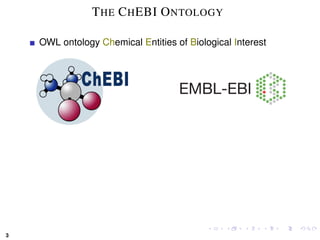
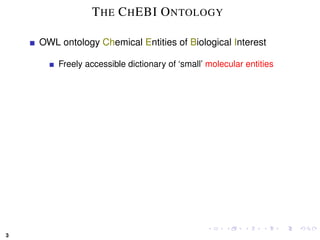

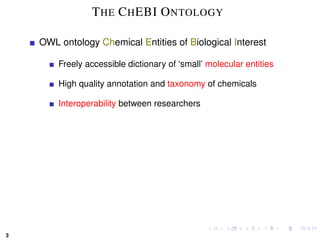


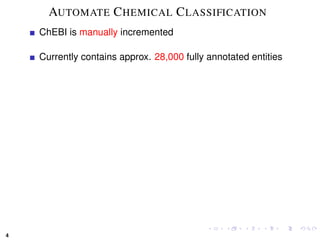











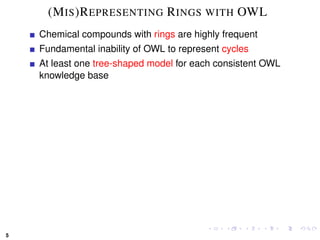



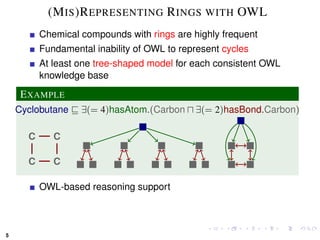

![OWL E XTENSIONS
Limitation of OWL to represent cycles (partially) remedied
by extension of OWL with Description Graphs and rules
[Motik et al., 2009]
6](https://image.slidesharecdn.com/slidesowled12-121123061306-phpapp02/85/Classifying-Chemicals-with-Description-Graphs-and-Logic-Programming-31-320.jpg)
![OWL E XTENSIONS
Limitation of OWL to represent cycles (partially) remedied
by extension of OWL with Description Graphs and rules
[Motik et al., 2009]
A Description Graph represents structures by means of a
directed labeled graph
6](https://image.slidesharecdn.com/slidesowled12-121123061306-phpapp02/85/Classifying-Chemicals-with-Description-Graphs-and-Logic-Programming-32-320.jpg)
![OWL E XTENSIONS
Limitation of OWL to represent cycles (partially) remedied
by extension of OWL with Description Graphs and rules
[Motik et al., 2009]
A Description Graph represents structures by means of a
directed labeled graph
E XAMPLE
Cyclobutadiene 1
C C Carbon 2 3 Carbon
C C Carbon 5 4 Carbon
6](https://image.slidesharecdn.com/slidesowled12-121123061306-phpapp02/85/Classifying-Chemicals-with-Description-Graphs-and-Logic-Programming-33-320.jpg)
![OWL E XTENSIONS
Limitation of OWL to represent cycles (partially) remedied
by extension of OWL with Description Graphs and rules
[Motik et al., 2009]
A Description Graph represents structures by means of a
directed labeled graph
E XAMPLE
Cyclobutadiene 1
C C Carbon 2 3 Carbon
C C Carbon 5 4 Carbon
6](https://image.slidesharecdn.com/slidesowled12-121123061306-phpapp02/85/Classifying-Chemicals-with-Description-Graphs-and-Logic-Programming-34-320.jpg)
![OWL E XTENSIONS
Limitation of OWL to represent cycles (partially) remedied
by extension of OWL with Description Graphs and rules
[Motik et al., 2009]
A Description Graph represents structures by means of a
directed labeled graph
E XAMPLE
Cyclobutadiene 1
C C Carbon 2 3 Carbon
C C Carbon 5 4 Carbon
Does cyclobutadiene have a conjugated four-membered
ring?
6](https://image.slidesharecdn.com/slidesowled12-121123061306-phpapp02/85/Classifying-Chemicals-with-Description-Graphs-and-Logic-Programming-35-320.jpg)
![OWL E XTENSIONS
Limitation of OWL to represent cycles (partially) remedied
by extension of OWL with Description Graphs and rules
[Motik et al., 2009]
A Description Graph represents structures by means of a
directed labeled graph
E XAMPLE
Cyclobutadiene 1
C C Carbon 2 3 Carbon
C C Carbon 5 4 Carbon
Does cyclobutadiene have a conjugated four-membered
ring?
6](https://image.slidesharecdn.com/slidesowled12-121123061306-phpapp02/85/Classifying-Chemicals-with-Description-Graphs-and-Logic-Programming-36-320.jpg)
![OWL E XTENSIONS
Limitation of OWL to represent cycles (partially) remedied
by extension of OWL with Description Graphs and rules
[Motik et al., 2009]
A Description Graph represents structures by means of a
directed labeled graph
E XAMPLE
Cyclobutadiene 1
Oxygen
C C Carbon 2 3 Carbon
C C Carbon 5 4 Carbon
6](https://image.slidesharecdn.com/slidesowled12-121123061306-phpapp02/85/Classifying-Chemicals-with-Description-Graphs-and-Logic-Programming-37-320.jpg)
![OWL E XTENSIONS
Limitation of OWL to represent cycles (partially) remedied
by extension of OWL with Description Graphs and rules
[Motik et al., 2009]
A Description Graph represents structures by means of a
directed labeled graph
E XAMPLE
Cyclobutadiene 1
Oxygen
C C Carbon 2 3 Carbon
C C Carbon 5 4 Carbon
∀hasAtom.(Carbon Hydrogen) Hydrocarbon
6](https://image.slidesharecdn.com/slidesowled12-121123061306-phpapp02/85/Classifying-Chemicals-with-Description-Graphs-and-Logic-Programming-38-320.jpg)
![OWL E XTENSIONS
Limitation of OWL to represent cycles (partially) remedied
by extension of OWL with Description Graphs and rules
[Motik et al., 2009]
A Description Graph represents structures by means of a
directed labeled graph
E XAMPLE
Cyclobutadiene 1
Oxygen
C C Carbon 2 3 Carbon
C C Carbon 5 4 Carbon
∀hasAtom.(Carbon Hydrogen) Hydrocarbon
Is cyclobutadiene a hydrocarbon?
6](https://image.slidesharecdn.com/slidesowled12-121123061306-phpapp02/85/Classifying-Chemicals-with-Description-Graphs-and-Logic-Programming-39-320.jpg)
![OWL E XTENSIONS
Limitation of OWL to represent cycles (partially) remedied
by extension of OWL with Description Graphs and rules
[Motik et al., 2009]
A Description Graph represents structures by means of a
directed labeled graph
E XAMPLE
Cyclobutadiene 1
Oxygen
C C Carbon 2 3 Carbon
C C Carbon 5 4 Carbon
∀hasAtom.(Carbon Hydrogen) Hydrocarbon
Is cyclobutadiene a hydrocarbon?
6](https://image.slidesharecdn.com/slidesowled12-121123061306-phpapp02/85/Classifying-Chemicals-with-Description-Graphs-and-Logic-Programming-40-320.jpg)





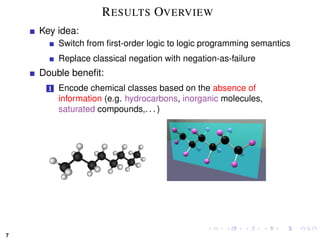





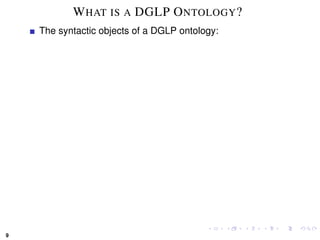

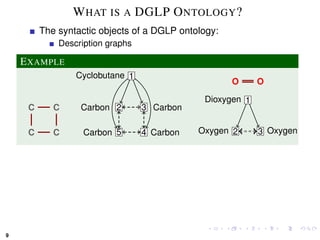







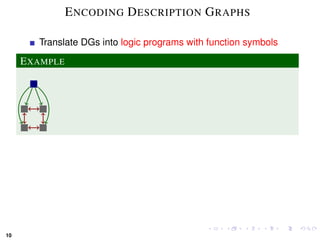
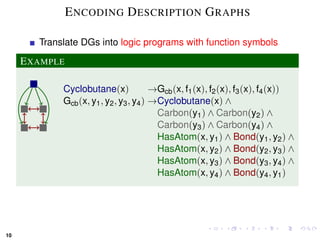













![ACYCLICITY C ONDITIONS
Formalisms extensively studied, e.g. Datalog±
Various syntax-based acyclicity conditions
weak acyclicity [Fagin et al., ICDT, 2002]
super-weak acyclicity [Marnette, PODS, 2009]
joint acyclicity [Krötzsch and Rudolph, IJCAI, 2011]
14](https://image.slidesharecdn.com/slidesowled12-121123061306-phpapp02/85/Classifying-Chemicals-with-Description-Graphs-and-Logic-Programming-77-320.jpg)
![ACYCLICITY C ONDITIONS
Formalisms extensively studied, e.g. Datalog±
Various syntax-based acyclicity conditions
weak acyclicity [Fagin et al., ICDT, 2002]
super-weak acyclicity [Marnette, PODS, 2009]
joint acyclicity [Krötzsch and Rudolph, IJCAI, 2011]
rule out naturally-arising nested structures
14](https://image.slidesharecdn.com/slidesowled12-121123061306-phpapp02/85/Classifying-Chemicals-with-Description-Graphs-and-Logic-Programming-78-320.jpg)
![ACYCLICITY C ONDITIONS
Formalisms extensively studied, e.g. Datalog±
Various syntax-based acyclicity conditions
weak acyclicity [Fagin et al., ICDT, 2002]
super-weak acyclicity [Marnette, PODS, 2009]
joint acyclicity [Krötzsch and Rudolph, IJCAI, 2011]
rule out naturally-arising nested structures
E XAMPLE
Carboxyl
O AceticAcid Carboxyl
Carbonyl 1 1
C
Methyl Hydroxyl
2 3 2 3
CH3 OH Methyl Carboxyl Carbonyl Hydroxyl
14](https://image.slidesharecdn.com/slidesowled12-121123061306-phpapp02/85/Classifying-Chemicals-with-Description-Graphs-and-Logic-Programming-79-320.jpg)
![ACYCLICITY C ONDITIONS
Formalisms extensively studied, e.g. Datalog±
Various syntax-based acyclicity conditions
weak acyclicity [Fagin et al., ICDT, 2002]
super-weak acyclicity [Marnette, PODS, 2009]
joint acyclicity [Krötzsch and Rudolph, IJCAI, 2011]
rule out naturally-arising nested structures
Novel semantic acyclicity condition
14](https://image.slidesharecdn.com/slidesowled12-121123061306-phpapp02/85/Classifying-Chemicals-with-Description-Graphs-and-Logic-Programming-80-320.jpg)
![ACYCLICITY C ONDITIONS
Formalisms extensively studied, e.g. Datalog±
Various syntax-based acyclicity conditions
weak acyclicity [Fagin et al., ICDT, 2002]
super-weak acyclicity [Marnette, PODS, 2009]
joint acyclicity [Krötzsch and Rudolph, IJCAI, 2011]
rule out naturally-arising nested structures
Novel semantic acyclicity condition
checks for generation of unbounded structures on the fly
14](https://image.slidesharecdn.com/slidesowled12-121123061306-phpapp02/85/Classifying-Chemicals-with-Description-Graphs-and-Logic-Programming-81-320.jpg)
![ACYCLICITY C ONDITIONS
Formalisms extensively studied, e.g. Datalog±
Various syntax-based acyclicity conditions
weak acyclicity [Fagin et al., ICDT, 2002]
super-weak acyclicity [Marnette, PODS, 2009]
joint acyclicity [Krötzsch and Rudolph, IJCAI, 2011]
rule out naturally-arising nested structures
Novel semantic acyclicity condition
checks for generation of unbounded structures on the fly
modelling of molecules that contain functional groups
14](https://image.slidesharecdn.com/slidesowled12-121123061306-phpapp02/85/Classifying-Chemicals-with-Description-Graphs-and-Logic-Programming-82-320.jpg)
![ACYCLICITY C ONDITIONS
Formalisms extensively studied, e.g. Datalog±
Various syntax-based acyclicity conditions
weak acyclicity [Fagin et al., ICDT, 2002]
super-weak acyclicity [Marnette, PODS, 2009]
joint acyclicity [Krötzsch and Rudolph, IJCAI, 2011]
rule out naturally-arising nested structures
Novel semantic acyclicity condition
checks for generation of unbounded structures on the fly
modelling of molecules that contain functional groups
O
Carbonyl
C
Methyl Hydroxyl
CH3 OH
Carboxyl
14](https://image.slidesharecdn.com/slidesowled12-121123061306-phpapp02/85/Classifying-Chemicals-with-Description-Graphs-and-Logic-Programming-83-320.jpg)


















